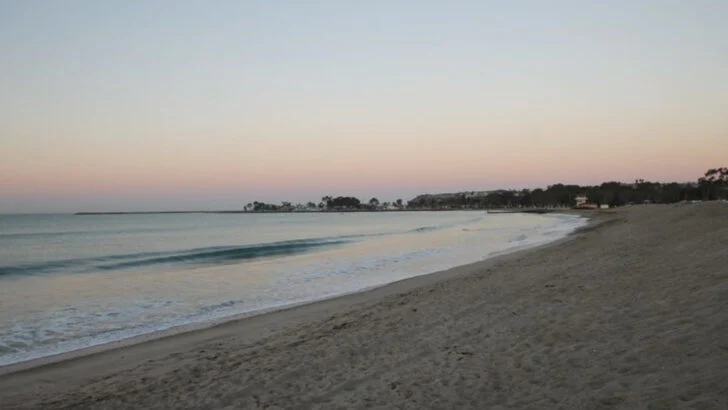Beaches are supposed to mean sun, sand, and salty waves—not warning signs and closed gates. Yet across the U.S., some of the most popular stretches of shoreline are turning swimmers away more often than you’d think. The culprit? Sky-high bacteria levels that make a refreshing dip anything but safe. Families plan their beach days, coolers packed and umbrellas ready, only to find red flags fluttering in the breeze. The water might look perfect, but beneath the sparkle lurks trouble. From coast to coast, closures are becoming a frustrating routine. It’s a reminder that even the most beloved beach towns can’t always promise a carefree swim. So, which beaches are repeat offenders? These are the sandy spots where bacteria keeps crashing the party—forcing visitors back onto their towels before they even get their feet wet.
Doheny State Beach – Dana Point, California
In the sunny embrace of Orange County lies Doheny State Beach, a bustling haven for surfers. Yet, beneath its inviting waves lurks a persistent issue: high fecal bacteria levels. Particularly near the creek outlet, urban runoff and nearby boat harbors are prime contributors to contamination. This picturesque stretch of sand often finds itself on alert, casting a shadow over its vibrant beach culture. Frequent closures serve as reminders of the environmental challenges faced by popular beaches. Despite this, dedicated efforts are underway to tackle pollution and improve water quality.
Cowell Beach – Santa Cruz, California
Cowell Beach, with its iconic boardwalk and stunning coastline, hides a notorious reputation. Known for frequent water quality issues, it struggles with poor circulation and pigeon droppings from the pier. The beach continuously battles its place on “most polluted” lists. However, beneath the surface lies a community resilient in addressing these environmental hurdles. While closures are common, they fuel efforts to restore its former glory. Walk along the boardwalk, and you’ll find a place striving for balance between nature’s beauty and human impact.
Imperial Beach – San Diego County, California
At the crossroads of California and Mexico, Imperial Beach offers a unique coastal experience. Yet, this location brings more than just serene landscapes; it faces frequent closures from sewage spills originating in the Tijuana River. Even after dry periods, bacteria levels remain alarmingly high. Visitors and locals are often caught between the allure of its sandy stretches and potential health risks. The community’s response to these challenges reflects a commitment to environmental restoration, aiming to safeguard this beautiful beach for future generations.
Lake Michigan Beaches – Indiana Dunes, Indiana
Indiana Dunes offers a unique freshwater beach experience along Lake Michigan, but beauty often comes alongside warnings of high E. coli levels. Industrial pollution and stormwater runoff play significant roles in these frequent closures. Visitors to Jeorse Park and other beaches find themselves navigating the delicate balance of enjoying nature while heeding health advisories. With each closure, the local community is reminded of the ongoing battle between maintaining industrial activity and preserving natural beauty. Efforts to improve water quality continue to be a community priority.
Venice Beach – Los Angeles, California
Venice Beach, a staple of Los Angeles culture, is renowned for its surf and lively boardwalk. However, the area’s storm drains and runoff frequently push bacteria levels over safe limits, particularly after heavy rains. Each closure paints a picture of the ongoing challenges faced by urban beachfronts. Local initiatives strive to address these issues, ensuring Venice Beach remains a vibrant destination. The community’s proactive stance highlights the constant push towards achieving a safe and enjoyable environment for all visitors.
East Beach – Galveston, Texas
East Beach in Galveston is synonymous with lively festivals and family outings, yet it often finds itself closing due to high bacteria levels after rain. Runoff from nearby streets and outdated sewage systems contribute significantly to these frequent issues. Each closure serves as a stark reminder of the delicate balance between vibrant human activity and environmental stewardship. The community of Galveston works diligently to monitor and improve water quality, eager to maintain East Beach as a safe and welcoming space for all.
Rehoboth Beach – Delaware
Rehoboth Beach is a beloved destination for Mid-Atlantic families, known for its charm and accessibility. However, it occasionally faces closures due to elevated bacteria counts following rainfall. This idyllic spot, nestled along Delaware’s coastline, sees diligent efforts by officials to monitor and swiftly respond to water quality concerns. Each closure highlights the interconnectedness of weather patterns and beachgoer safety. Despite these challenges, Rehoboth Beach continues to captivate visitors with its timeless appeal and community spirit, striving for harmonious coexistence with nature.
Huntington Beach – Orange County, California
Huntington Beach, often referred to as “Surf City USA,” is a vibrant coastal destination known for its lively atmosphere and surfing culture. Despite its appeal, the beach sometimes faces closures due to bacteria levels, especially after heavy rains. These rains can wash pollutants from urban areas into the ocean, temporarily affecting water quality.
Visitors should check local advisories before planning a beach day to ensure safety. The city works tirelessly to improve water conditions, implementing measures to reduce pollution.
As a renowned surf spot, the community remains passionate about maintaining the beach’s reputation and environmental health.

